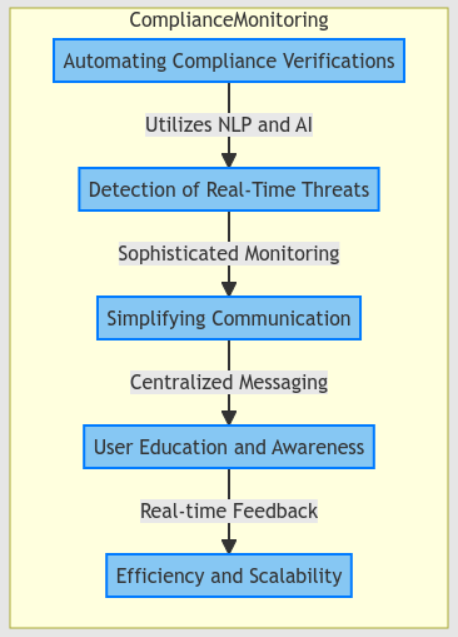By: Pinaki Sahu, International Centre for AI and Cyber Security Research and Innovations (CCRI), Asia University, Taiwan, 0000pinaki1234.kv@gmail.com
Abstract
This article delves into the critical significance of compliance monitoring powered by chatbots in bolstering the security of cloud environments. By harnessing the capabilities of artificial intelligence, these chatbots are able to scale, automate monitoring processes, deliver immediate alerts, ensure ongoing compliance evaluations, and educate users. The integration of chatbots and cloud security offers businesses a dynamic recovery as they navigate the ever-changing digital environment.
Introduction
How businesses deploy and administer their IT infrastructure has been fundamentally transformed by the exponential growth of cloud computing. Although the cloud provides extraordinary adaptability and capacity for expansion, it also presents novel challenges, specifically with regard to assurance and a commitment to regulations. As a growing number of organizations transition their critical duties and sensitive data to the cloud, compliance with internal security policies and industry regulations becomes of the utmost importance. Within this particular framework, compliance monitoring powered by chatbots arises as a potent remedy for bolstering security, optimizing operations, and proactively mitigating potential susceptibilities[1].
The Increasing Significance of Compliance and Security in the Cloud
- The Transition to Cloud Technology: Offering on-demand access to storage, applications, and computing resources, cloud computing has emerged as the foundation of contemporary business management. This transition facilitates the dynamic scaling of organizations, cost reduction, and enhanced overall efficiency. It also exposes them to a new set of security challenges, such as compliance issues, data breaches, and unauthorized access[2].
- Aspects of Compliance in the Cloud: Non-compliance with the diverse compliance regulations that constitute industry and regional standards may lead to significant repercussions, including legal sanctions, harm to one’s reputation, and erosion of consumer confidence. Due to the continuous provisioning and disconnecting of infrastructure within cloud environments, compliance management is especially difficult to achieve in the cloud[2].
The Significance of Compliance Monitoring Driven by Chat Bot assistance

This flow chart represents the Compliance Monitoring using Chatbot assistance, explaining the key steps in the process:
- Automating Compliance Verifications: Conventional approaches to monitoring compliance frequently rely on labour-intensive, fallible manual audits that may fail to provide up-to-date information. Compliance monitoring powered by chatbots automates these assessments through the utilization of natural language processing (NLP) and artificial intelligence (AI). This increases the efficiency of the process and decreases the probability of human error[3].
- Detection of Real-Time Threats: Chatbots that are outfitted with sophisticated monitoring functionalities have the ability to consistently examine cloud environments for any breaches of established compliance standards. Real-time threat detection facilitates the prompt identification and resolution of potential security vulnerabilities by organizations, thereby safeguarding against unauthorized access and data breaches[3].
- Simplifying Communication :Chatbots serve as an intermediary between various organizational stakeholders, such as compliance officers, security professionals, and IT teams. Through the utilization of a centralized messaging interface, these tools enable collaboration and guarantee that all individuals are in agreement with respect to security and compliance protocols.
- User Education and Awareness: Chatbots may be extremely helpful in informing users about compliance requirements and security best practises. These chatbots can assist users understand the effects of their activities on security and compliance by offering them real-time feedback and guidance through interactive discussions. The organization’s culture of security awareness is bolstered by this proactive approach to user education.
- Efficiency and Scalability: Because cloud systems are scalable and dynamic, traditional compliance monitoring solutions could find it difficult to stay up. Because they are naturally scalable, chatbots can easily adjust to the shifting requirements of cloud infrastructures. They are perfect for monitoring and guaranteeing compliance in extremely dynamic cloud settings because of their effectiveness in managing big information and a variety of workloads.
Conclusion
The increasing adoption of cloud technology by organisations highlights the critical need to secure these environments. An effective and flexible way to handle the changing demands of cloud security is through chat-bot-driven compliance monitoring. Chat-bots play a critical role in protecting cloud environments against cyber risks by automating monitoring procedures, giving scalability, delivering rapid alerts, guaranteeing continuous compliance evaluation, and educating users. Businesses can navigate the digital world with confidence, knowing that their data is not only accessible and adaptable but also safe and compliant, as long as AI-driven chatbots and cloud security continue to advance in synergy.
References
- Kalaiprasath, R., Elankavi, R., & Udayakumar, R. (2017). Cloud security and compliance-a semantic approach in end to end security. International Journal on Smart Sensing and Intelligent Systems, 10(5), 482-494.
- Hashmi, A., Ranjan, A., & Anand, A. (2018). Security and compliance management in cloud computing. International Journal of Advanced Studies in Computers, Science and Engineering, 7(1), 47-54.
- Calvaresi, D., Calbimonte, J. P., Siboni, E., Eggenschwiler, S., Manzo, G., Hilfiker, R., & Schumacher, M. (2021). EREBOTS: Privacy-compliant agent-based platform for multi-scenario personalized health-assistant chatbots. Electronics, 10(6), 666.
- Wang, L., Li, L., Li, J., Li, J., Gupta, B. B., & Liu, X. (2018). Compressive sensing of medical images with confidentially homomorphic aggregations. IEEE Internet of Things Journal, 6(2), 1402-1409.
- Stergiou, C. L., Psannis, K. E., & Gupta, B. B. (2021). InFeMo: flexible big data management through a federated cloud system. ACM Transactions on Internet Technology (TOIT), 22(2), 1-22.
- Gupta, B. B., Perez, G. M., Agrawal, D. P., & Gupta, D. (2020). Handbook of computer networks and cyber security. Springer, 10, 978-3.
- Bhushan, K., & Gupta, B. B. (2017). Security challenges in cloud computing: state-of-art. International Journal of Big Data Intelligence, 4(2), 81-107.
Cite As
Sahu P. (2024) Securing Cloud Environments through Chat-Bot-Driven Compliance Monitoring, Insights2Techinfo, pp.1